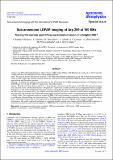Por favor, use este identificador para citar o enlazar a este item:
http://hdl.handle.net/10261/267240COMPARTIR / EXPORTAR:
 SHARE SHARE
 CORE
BASE CORE
BASE
|
|
| Visualizar otros formatos: MARC | Dublin Core | RDF | ORE | MODS | METS | DIDL | DATACITE | |

| Título: | Sub-arcsecond LOFAR imaging of Arp 299 at 150 MHz: Tracing the nuclear and diffuse extended emission of a bright LIRG |
Autor: | Ramírez Olivencia, Naim; Varenius, E.; Pérez-Torres, Miguel A. CSIC ORCID ; Alberdi, Antxón CSIC ORCID ; Conway, J. E.; Alonso-Herrero, A. CSIC ORCID; Pereira-Santaella, Miguel CSIC ORCID; Herrero-Illana, Rubén CSIC ORCID | Palabras clave: | Instrumentation: high angular resolution ISM: jets and outflows HII regions ISM: magnetic fields Galaxies: star formation Radio continuum: galaxies |
Fecha de publicación: | 25-ene-2022 | Editor: | EDP Sciences | Citación: | Astronomy & Astrophysics 658: A4 (2022) | Resumen: | Context. Arp 299 is the brightest luminous infrared galaxy (LIRG) within 50 Mpc, with IR luminosity log(LIR/L⊙) = 11.9. It provides a unique laboratory for testing physical processes in merging galaxies. Aims. We study for the first time the low-frequency (∼150 MHz) radio brightness distribution of Arp 299 at subarcsecond resolution, tracing in both compact and extended emission regions the local spectral energy distribution (SED) in order to characterize the dominant emission and absorption processes. Methods. We analysed the spatially resolved emission of Arp 299 revealed by 150 MHz international baseline Low-Frequency Array (LOFAR) and 1.4, 5.0, and 8.4 GHz Very Large Array (VLA) observations. Results. We present the first subarcsecond (0.4″ ×100 pc) image of the whole Arp 299 system at 150 MHz. The high surface brightness sensitivity of our LOFAR observations (∼100 μJy beam-1) allowed us to detect all of the nuclear components detected at higher frequencies, as well as the extended steep-spectrum emission surrounding the nuclei. We obtained spatially resolved, two-point spectral index maps for the whole galaxy: the compact nuclei show relatively flat spectra, while the extended, diffuse component shows a steep spectrum. We fitted the radio SED of the nuclear regions using two different models: a continuous free-free medium model and a clumpy model. The continuous model can explain the SED of the nuclei assuming a population of relativistic electrons subjected to synchrotron, bremsstrahlung, and ionization losses. The clumpy model fits assuming relativistic electrons with negligible energy losses, and thermal fractions that are more typical of star-forming galaxies than those required for the continuous model. Conclusions. Our results confirm the usefulness of combining spatially resolved radio imaging at both MHz and GHz frequencies to characterize in detail the radio emission properties of LIRGs from the central 100 pc out to the kiloparsec galaxy-wide scales. © ESO 2022. | Versión del editor: | http://dx.doi.org/10.1051/0004-6361/202140822 | URI: | http://hdl.handle.net/10261/267240 | DOI: | 10.1051/0004-6361/202140822 | ISSN: | 0004-6361 | E-ISSN: | 1432-0746 |
| Aparece en las colecciones: | (IAA) Artículos (ICE) Artículos |
Ficheros en este ítem:
| Fichero | Descripción | Tamaño | Formato | |
|---|---|---|---|---|
| 2022AA_658A_4R.pdf | 25,11 MB | Adobe PDF |  Visualizar/Abrir |
CORE Recommender
SCOPUSTM
Citations
8
checked on 11-may-2024
WEB OF SCIENCETM
Citations
7
checked on 23-feb-2024
Page view(s)
50
checked on 14-may-2024
Download(s)
33
checked on 14-may-2024
Google ScholarTM
Check
Altmetric
Altmetric
NOTA: Los ítems de Digital.CSIC están protegidos por copyright, con todos los derechos reservados, a menos que se indique lo contrario.
